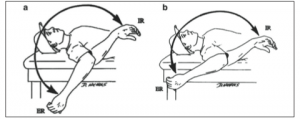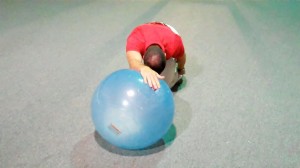I see plenty of pitchers in my clinic ranging from 12 y/o travel baseball players to MLB guys. My own son is a left handed pitcher so I am always carefully watching his mechanics, pitch count and arm care. There has been much written about glenohumeral internal rotation deficit (GIRD) and total shoulder motion over the years.

Today, I wanted to recap a nice article that was recently published in the American Journal of Sports Medicine by Wilk et al. looking at deficits in glenohumeral passive range of motion (PROM) and the increase in elbow injury risk.
This prospective study was done over an 8 year period from 2005-2102 and looked at PROM of both throwing and nonthrowing shoulders of all major and minor league pitchers within a single baseball organization. The measurements were taken with a bubble goniometer during spring training. See images below from the journal article for how measurements were taken:

In sum, 505 exams were performed on 296 pitchers. Motion was assessed in supine with the arm abducted to 90 degrees and the arm in the plane of the scapula. One examiner stabilized the scapula, while another measured total rotation and passive flexion. Elbow injuries and days missed because of injuries were assessed and recorded by medical staff. Throwing and nonthrowing measurements were compared, while additional testing was done to find significant associations between shoulder motion and elbow injury, as well as odds of an elbow injury.
Results
- Significant differences were discovered among subjects when comparing them side-to-side
- 49 elbow injuries & 8 surgeries were noted in 38 players = 2,551 days missed
- GIRD was not associated with elbow injuries
- External rotation insufficiency was not linked to elbow injuries
- Pitchers with deficits of greater than 5 degrees of total rotation (ER + IR) in the throwing shoulders had a 2.6x greater risk for injury
- Pitchers with a deficit of greater than 5 degrees of shoulder flexion in the throwing shoulder had a 2.8x greater risk for injury
There is always lots of discussion about GIRD and posterior shoulder stretching for throwers. Clearly we need to be aware of asymmetry (and expect it) in this population; however, identifying total ROM deficits and likewise pathological GIRD is the key to making sound decisions with doing effective joint mobilizations and posterior shoulder stretching. The finding of flexion deficits being linked to elbow injuries is new and interesting.
Limited overhead flexion would seem to correlate with probably latissimus dorsi tightness and may also represent some scapular dysfunction in the subject. This would seem to further highlight the importance of soft tissue mobilization and routine mobility work in this group of athletes. I routinely find trigger points in the lats, so using MFR techniques or trigger point dry needling can be an effective way to resolve tightness. I also like to use ipisilateral lat stretching to work on ROM after mobilization efforts (see image below).

It should be noted there were some weaknesses in this study that included measurements being taken on the first day of spring training so pitchers had not been throwing in game situations yet, several injury records did not report severity or extent of injuries,, active ROM was not assessed so unable to say if it would be significant or vary much, and finally the authors were not sure if all teams use the same definition of injury and whether all days spent on the DL are truly injury days.
Despite these weaknesses, we as therapists and strength coaches must be aware of the impact of total motion deficits and how to integrate the appropriate manual techniques and exercises within the prehab, rehab and training regimens of these athletes to maximize performance and prevent injury.
Reference
Wilk KE, Macrina LC, Fleisig GS, Aune KT. Porterfield RA, Harker P, Evans, TJ, Andrews JR. Deficits in glenohumeral passive range of motion increase risk of elbow injury in professional baseball pitchers. Am J Sports Med. 2014;42(9):2075-2081.

